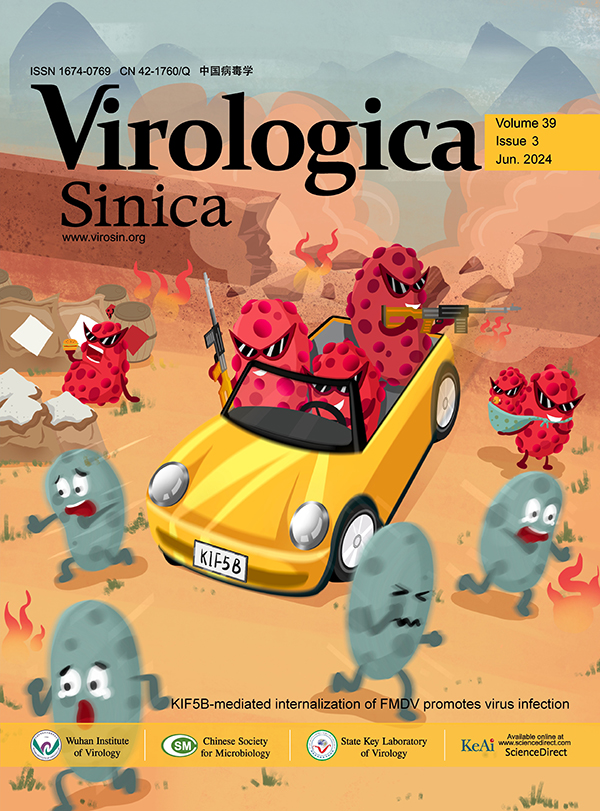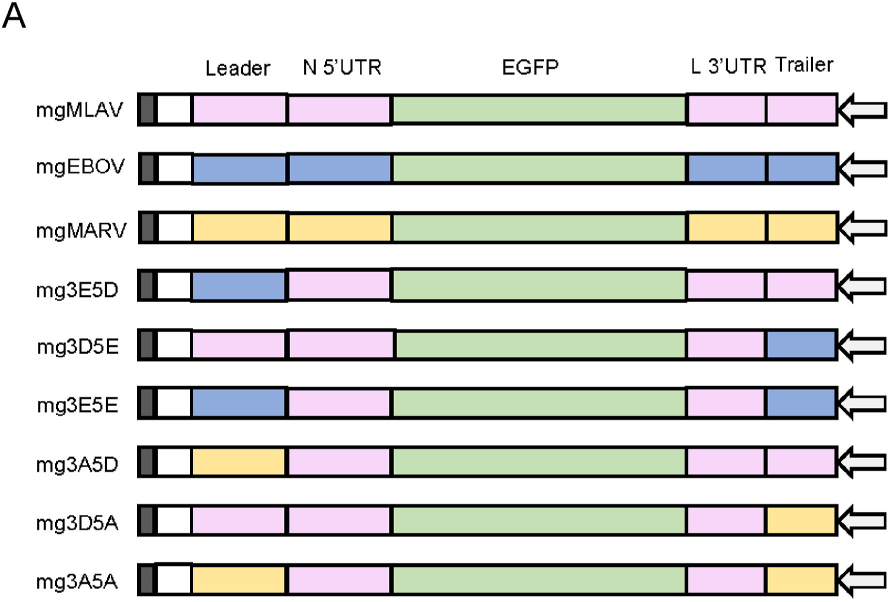-
Albarino CG, Uebelhoer LS, Vincent JP, Khristova ML, Chakrabarti AK, McElroy A, Nichol ST, Towner JS. 2013. Development of a reverse genetics system to generate recombinant marburg virus derived from a bat isolate. Virology, 446: 230-237.
-
Bach S, Demper JC, Klemm P, Schlereth J, Lechner M, Schoen A, Kaemper L, Weber F, Becker S, Biedenkopf N, Hartmann RK. 2021. Identification and characterization of short leader and trailer RNAs synthesized by the Ebola virus RNA polymerase. PLoS Pathog., 17: e1010002.
-
Bodmer BS, Zierke L, Wendt L, Gressler J, Groseth A, Hoenen T. 2021. Remdesivir inhibits the polymerases of the novel filoviruses Lloviu and Bombali virus. Antiviral Res., 192: 105120.
-
Boehmann Y, Enterlein S, Randolf A, Muhlberger E. 2005. A reconstituted replication and transcription system for Ebola virus reston and comparison with Ebola virus zaire. Virology, 332: 406-417.
-
Brown AJ, Won JJ, Graham RL, Dinnon KH, Sims AC, Feng JY, Cihlar T, Denison MR, Baric RS, Sheahan TP. 2019. Broad spectrum antiviral remdesivir inhibits human endemic and zoonotic deltacoronaviruses with a highly divergent RNA dependent rna polymerase. Antiviral Res., 169: 104541.
-
Brown CS, Lee MS, Leung DW, Wang T, Xu W, Luthra P, Anantpadma M, Shabman RS, Melito LM, MacMillan KS, Borek DM, Otwinowski Z, Ramanan P, Stubbs AJ, Peterson DS, Binning JM, Tonelli M, Olson MA, Davey RA, Ready JM, Basler CF, Amarasinghe GK. 2014. In silico derived small molecules bind the filovirus VP35 protein and inhibit its polymerase cofactor activity. J. Mol. Biol., 426: 2045-2058.
-
Cao, Z., Liu, C., Peng, C., Ran, Y., Yao, Y., Xiao, G., Li, E., Chen, Z., Chuai, X., Chiu, S. 2023. Ebola virus VP35 perturbs type I interferon signaling to facilitate viral replication. Virol. Sin., 38: 922-930.
-
Crameri G, Todd S, Grimley S, McEachern JA, Marsh GA, Smith C, Tachedjian M, De Jong C, Virtue ER, Yu M, Bulach D, Liu JP, Michalski WP, Middleton D, Field HE, Wang LF. 2009. Establishment, immortalisation and characterisation of pteropid bat cell lines. PLoS One, 4: e8266.
-
Deflube LR, Cressey TN, Hume AJ, Olejnik J, Haddock E, Feldmann F, Ebihara H, Fearns R, Muhlberger E. 2019. Ebolavirus polymerase uses an unconventional genome replication mechanism. Proc. Natl. Acad. Sci. U. S. A., 116: 8535-8543.
-
Du XH, Zuo XY, Meng F, Wu F, Zhao X, Li CF, Cheng GH, Qin FXF. 2020. Combinatorial screening of a panel of FDA-approved drugs identifies several candidates with anti-Ebola activities. Biochem. Biophys. Res. Commun., 522: 862-868.
-
Edwards MR, Pietzsch C, Vausselin T, Shaw ML, Bukreyev A, Basler CF. 2015. High-throughput minigenome system for identifying small-molecule inhibitors of Ebola virus replication. ACS Infect. Dis., 1: 380-387.
-
Enterlein S, Volchkov V, Weik M, Kolesnikova L, Volchkova V, Klenk HD, Muhlberger E. 2006. Rescue of recombinant Marburg virus from cDNA is dependent on nucleocapsid protein VP30. J. Virol., 80: 1038-1043.
-
Hoenen T, Groseth A, de Kok-Mercado F, Kuhn JH, Wahl-Jensen V. 2011. Minigenomes, transcription and replication competent virus-like particles and beyond: reverse genetics systems for filoviruses and other negative stranded hemorrhagic fever viruses. Antiviral Res., 91: 195-208.
-
Horie M. 2021. Identification of a novel filovirus in a common lancehead (bothrops atrox (linnaeus, 1758)). J. Vet. Med. Sci., 83: 1485-1488.
-
Kemenesi G, Toth GE, Mayora-Neto M, Scott S, Temperton N, Wright E, Muhlberger E, Hume AJ, Suder EL, Zana B, Boldogh SA, Gorfol T, Estok P, Lanszki Z, Somogyi BA, Nagy A, Pereszlenyi CI, Dudas G, Foldes F, Kurucz K, Madai M, Zeghbib S, Maes P, Vanmechelen B, Jakab F. 2022. Isolation of infectious Lloviu virus from Schreiber's bats in Hungary. Nat. Commun., 13: 1706.
-
Koch LK, Cunze S, Kochmann J, Klimpel S. 2020. Bats as putative Zaire ebolavirus reservoir hosts and their habitat suitability in Africa. Sci. Rep., 10: 14268.
-
Lo MK, Jordan R, Arvey A, Sudhamsu J, Shrivastava-Ranjan P, Hotard AL, Flint M, McMullan LK, Siegel D, Clarke MO, Mackman RL, Hui HC, Perron M, Ray AS, Cihlar T, Nichol ST, Spiropoulou CF. 2017. GS-5734 and its parent nucleoside analog inhibit filo-, pneumo-, and paramyxoviruses. Sci. Rep., 7: 43395.
-
Lo MK, Albarino CG, Perry JK, Chang S, Tchesnokov EP, Guerrero L, Chakrabarti A, Shrivastava-Ranjan P, Chatterjee P, McMullan LK, Martin R, Jordan R, Gotte M, Montgomery JM, Nichol ST, Flint M, Porter D, Spiropoulou CF. 2020. Remdesivir targets a structurally analogous region of the Ebola virus and SARS-Cov-2 polymerases. Proc. Natl. Acad. Sci. U. S. A., 117: 26946-26954.
-
Luo Y, Chen Y, Geng R, Li B, Chen J, Zhao K, Zheng XS, Zhang W, Zhou P, Yang XL, Shi ZL. 2021. Broad cell tropism of SADS-Cov in vitro implies its potential cross-species infection risk. Virol. Sin., 36: 559-563.
-
Malin JJ, Suarez I, Priesner V, Fatkenheuer G, Rybniker J. 2020. Remdesivir against COVID-19 and other viral diseases. Clin. Microbiol. Rev., 34: e00162-20.
-
Manhart WA, Pacheco JR, Hume AJ, Cressey TN, Deflube LR, Muhlberger E. 2018. A chimeric Lloviu virus minigenome system reveals that the bat-derived filovirus replicates more similarly to ebolaviruses than marburgviruses. Cell Rep., 24: 2573-2580.e4.
-
Martin B, Canard B, Decroly E. 2017. Filovirus proteins for antiviral drug discovery: structure/function bases of the replication cycle. Antiviral Res., 141: 48-61.
-
McCarthy SD, Majchrzak-Kita B, Racine T, Kozlowski HN, Baker DP, Hoenen T, Kobinger GP, Fish EN, Branch DR. 2016. A rapid screening assay identifies monotherapy with interferon-ss and combination therapies with nucleoside analogs as effective inhibitors of Ebola virus. PLoS Negl. Trop. Dis., 10: e0004364.
-
Muhlberger E. 2007. Filovirus replication and transcription. Future Virol., 2: 205-215.
-
Muhlberger E, Lotfering B, Klenk HD, Becker S. 1998. Three of the four nucleocapsid proteins of Marburg virus, NP, VP35, and L, are sufficient to mediate replication and transcription of Marburg virus-specific monocistronic minigenomes. J. Virol., 72: 8756-8764.
-
Muhlberger E, Weik M, Volchkov VE, Klenk HD, Becker S. 1999. Comparison of the transcription and replication strategies of Marburg virus and Ebola virus by using artificial replication systems. J. Virol., 73: 2333-2342.
-
Negredo A, Palacios G, Vazquez-Moron S, Gonzalez F, Dopazo H, Molero F, Juste J, Quetglas J, Savji N, de la Cruz Martinez M, Herrera JE, Pizarro M, Hutchison SK, Echevarria JE, Lipkin WI, Tenorio A. 2011. Discovery of an ebolavirus-like filovirus in europe. PLoS Pathog., 7: e1002304.
-
Nelson EV, Pacheco JR, Hume AJ, Cressey TN, Deflube LR, Ruedas JB, Connor JH, Ebihara H, Muhlberger E. 2017. An RNA polymerase II-driven Ebola virus minigenome system as an advanced tool for antiviral drug screening. Antiviral Res., 146: 21-27.
-
Olival KJ, Hayman DT. 2014. Filoviruses in bats: current knowledge and future directions. Viruses, 6: 1759-1788.
-
Rougeron V, Feldmann H, Grard G, Becker S, Leroy EM. 2015. Ebola and marburg haemorrhagic fever. J. Clin. Virol., 64: 111-119.
-
Shi M, Lin XD, Chen X, Tian JH, Chen LJ, Li K, Wang W, Eden JS, Shen JJ, Liu L, Holmes EC, Zhang YZ. 2018. The evolutionary history of vertebrate RNA viruses. Nature, 556: 197-202.
-
Siegel D, Hui HC, Doerffler E, Clarke MO, Chun K, Zhang L, Neville S, Carra E, Lew W, Ross B, Wang Q, Wolfe L, Jordan R, Soloveva V, Knox J, Perry J, Perron M, Stray KM, Barauskas O, Feng JY, Xu Y, Lee G, Rheingold AL, Ray AS, Bannister R, Strickley R, Swaminathan S, Lee WA, Bavari S, Cihlar T, Lo MK, Warren TK, Mackman RL. 2017. Discovery and synthesis of a phosphoramidate prodrug of a pyrrolo[2,1-f][triazin-4-amino] adenine C-nucleoside (GS-5734) for the treatment of Ebola and emerging viruses. J. Med. Chem., 60: 1648-1661.
-
Sztuba-Solinska J, Diaz L, Kumar MR, Kolb G, Wiley MR, Jozwick L, Kuhn JH, Palacios G, Radoshitzky SR, Le Grice SFJ, Johnson RF. 2016. A small stem-loop structure of the Ebola virus trailer is essential for replication and interacts with heat-shock protein A8. Nucleic Acids Res., 44: 9831-9846.
-
Theriault S, Groseth A, Neumann G, Kawaoka Y, Feldmann H. 2004. Rescue of Ebola virus from cDNA using heterologous support proteins. Virus Res., 106: 43-50.
-
Volchkov V.E., Volchkova V.A., Muhlberger E, Kolesnikova L.V., Weik M, Dolnik O, Klenk HD. 2001. Recovery of infectious Ebola virus from complementary DNA: RNA editing of the GP gene and viral cytotoxicity. Science, 291: 1965-1969.
-
Watt A., Moukambi F., Banadyga L, Groseth A, Callison J, Herwig A, Ebihara H, Feldmann H, Hoenen T. 2014. A novel life cycle modeling system for Ebola virus shows a genome length-dependent role of VP24 in virus infectivity. J. Virol., 88: 10511-10524.
-
Williams CG, Gibbons JS, Keiffer TR, Luthra P, Edwards MR, Basler CF. 2020. Impact of Mengla virus proteins on human and bat innate immune pathways J. Virol., 94: e00191-20.
-
Yang XL, Tan CW, Anderson DE, Jiang RD, Li B, Zhang W, Zhu Y, Lim XF, Zhou P, Liu XL, Guan W, Zhang L, Li SY, Zhang YZ, Wang LF, Shi ZL. 2019. Characterization of a filovirus (Mengla virus) from rousettus bats in China. Nat. Microbiol., 4: 390-395.












 DownLoad:
DownLoad: